5.3 Fungi
Fungi are a diverse kingdom of eukaryotic organisms that obtain nutrients by absorbing them from organic matter. While scientists have identified over 100,000 species of fungi, this is only a fraction of the over two million species that likely exist. They include mushrooms, yeasts, moulds, and more.

Structure
Fungi are made up of eukaryotic cells, meaning they have a nucleus and other membrane-bound organelles. Most fungi grow as hyphae, thread-like structures that form a network called a mycelium (Figure 5.3.2), which allows them to efficiently absorb nutrients from their surroundings.
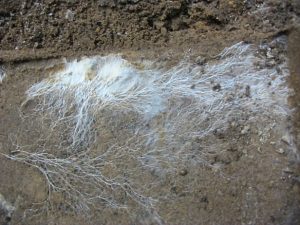

Fungi were once considered plant-like organisms, but DNA evidence has shown that fungi are more closely related to animals. Like animals, fungi are heterotrophic – they cannot perform photosynthesis because they do not have chloroplasts. Fungi share a few other traits with animals. Their cell walls are composed of chitin, the same tough material found in the exoskeletons of arthropods. Like animals, fungi also store carbohydrates as glycogen.
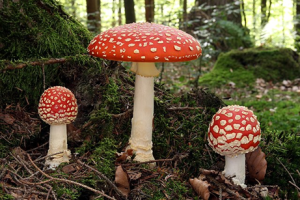
Fungi also produce a variety of pigments, including melanin, which helps protect cells from ultraviolet (UV) radiation – a function it also serves in human skin and hair. Other fungal pigments may be toxic or unpalatable, which deters animals from eating them. For example, the bright red pigment in Amanita muscaria (fly agaric) serves as a warning of its toxicity.
Some fungi, like yeasts, are unicellular, but most are multicellular and form visible structures like mushrooms. Most fungi are nonmotile, meaning they don’t move.
Nutrition
Fungi are heterotrophs, meaning they obtain their food from other organisms. However, unlike animals that ingest food and then digest it internally, fungi take a different approach. They secrete enzymes into their environment to break down complex organic materials into simpler molecules, which they then absorb through their cell walls.
Fungi use different strategies to access nutrients. Most fungi act as decomposers, breaking down dead organic matter such as fallen leaves, wood, and animal remains. These fungi play a crucial role in recycling nutrients in ecosystems. Others are parasites which feed on living organisms and often cause disease (see Pathogenic Fungi below). Still others form mutualistic relationships with other organisms (see Mutualistic Fungi below).
Reproduction
Many fungi can reproduce sexually and asexually, depending on environmental conditions. For example, when resources are plentiful, asexual reproduction may dominate. In contrast, stressful or changing conditions may trigger sexual reproduction to produce more resilient offspring.
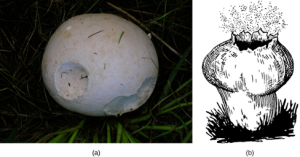
In both sexual and asexual reproduction, fungi reproduce using spores, which are tiny, often microscopic cells capable of growing into new fungi. Spores disperse from the parent organism by either floating on the wind or hitching a ride on an animal. Fungal spores are smaller and lighter than plant seeds. For example, the giant puffball mushroom bursts open and releases trillions of spores in a massive cloud of what looks like finely particulate dust. The huge number of spores released increases the likelihood of landing in an environment that will support growth (Figure 5.3.5).
In many common fungi, what we recognize as a mushroom is actually just the reproductive structure, known as the fruiting body. This is the visible part of the fungus that emerges above ground to release spores. The main body of the fungus (the mycelium) is typically hidden in soil, wood, or other organic material. On the underside of the mushroom cap are thin, blade-like structures called gills, which provide a large surface area for spore production and dispersal.
Beneficial Fungi
Importance to Ecosystems
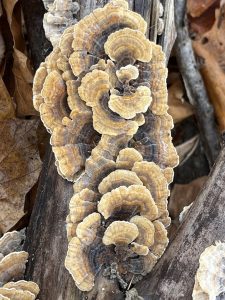
Food webs would be incomplete without organisms that decompose organic matter, and fungi are key participants in this process. Decomposition allows for cycling of nutrients such as carbon, nitrogen, and phosphorus back into the environment so they are available to living things, rather than being trapped in dead organisms. Fungi are particularly important because they have evolved enzymes to break down cellulose and lignin, components of plant cell walls that few other organisms are able to digest, releasing their carbon content.
Another crucial role fungi play in ecosystems is forming mycorrhizae, mutually beneficial associations with plant roots. Mycorrhiza, a term combining the Greek roots myco (fungus) and rhizo (root), refers to the symbiotic relationship between vascular plant roots and fungi. Somewhere between 80–90% of all plant species have mycorrhizal partners. In these associations, the fungal mycelia use their extensive network of hyphae and large surface area in contact with the soil to channel water and minerals into the plant. In return, the plant provides the fungus with sugars produced through photosynthesis to fuel its metabolism.

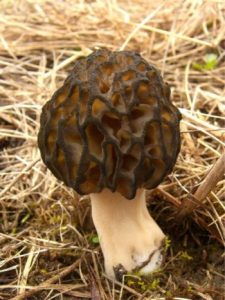
Food Production
Fungi have long been used in the production of food and beverages. Yeasts are single-celled fungi that play a key role in fermentation. They help make bread rise and are essential in brewing beer and fermenting wine.
We also eat many types of fungi. Some mushrooms, like morels, shiitake mushrooms, chanterelles, and truffles, are even considered delicacies (Figure 5.3.8).
Medicine and Pharmaceuticals
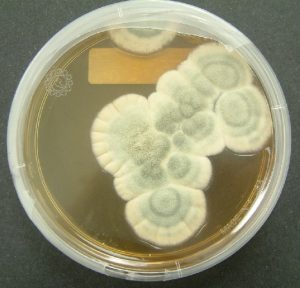
Fungi have had a profound impact on modern medicine. The discovery of penicillin, the first widely used antibiotic, came from the fungus Penicillium notatum and revolutionized the treatment of bacterial infections. Since then, fungi have been used to develop a variety of other important drugs. Some fungal compounds are used to suppress the immune system in transplant patients, while others help manage chronic conditions such as high cholesterol. Ongoing research continues to explore fungi as sources of new antibiotics and even as anticancer agents.
Harmful Fungi
While many fungi are beneficial, others can cause harm to a variety of different organisms.
Plant Pathogens
Fungi are responsible for many serious plant diseases that affect both wild and cultivated species. For example, Dutch elm disease is a particularly devastating fungal infection that destroys many native species of elm (Ulmus spp.). The fungus infects the vascular system of the tree. It was accidentally introduced to North America in the 1900s and decimated elm trees across the continent. Dutch elm disease is caused by the fungus Ophiostoma ulmi. The elm bark beetle acts as a vector and transmits the disease from tree to tree. Many European and Asiatic elms are less susceptible than American elms.
The production of enough good-quality crops is essential to our existence. Plant diseases have ruined crops, bringing widespread famine. Most plant pathogens are fungi that cause tissue decay and eventual death of the host (Figure 5.3.10). In addition to destroying plant tissue directly, some plant pathogens spoil crops by producing potent toxins. Fungi are also responsible for food spoilage and the rotting of stored crops. For example, the fungus Claviceps purpurea causes ergot, a disease of cereal crops (especially of rye). Although the fungus reduces the yield of cereals, the effects of the ergot’s alkaloid toxins on humans and animals are of much greater significance: In animals, the disease is referred to as ergotism. The most common signs and symptoms are convulsions, hallucination, gangrene, and loss of milk in cattle. The active ingredient of ergot is lysergic acid, which is a precursor of the drug LSD. Smuts, rusts, and powdery or downy mildew are other examples of common fungal pathogens that affect crops.
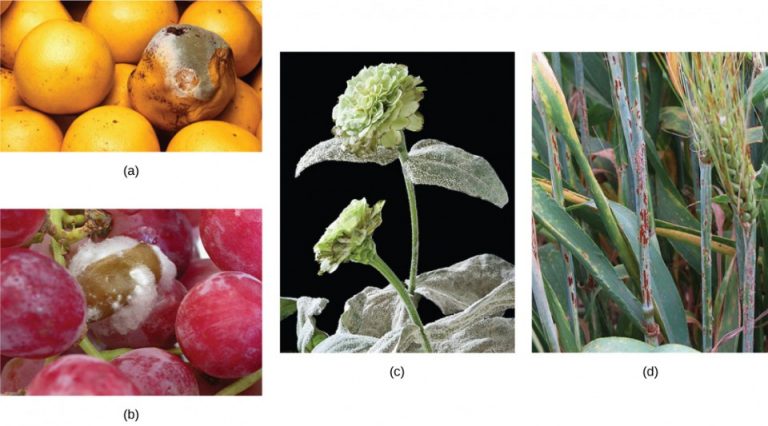
Animal pathogens

Fungi can affect animals, including humans, in several ways. Fungi attack animals directly by colonizing and destroying tissues. Humans and other animals can be poisoned by eating toxic mushrooms or foods contaminated by fungi. In addition, individuals who display hypersensitivity to moulds and spores develop strong and dangerous allergic reactions. Fungal infections are generally very difficult to treat because, unlike bacteria, fungi are eukaryotes. Antibiotics only target prokaryotic cells, whereas compounds that kill fungi also adversely affect the eukaryotic animal host.
Many fungal infections (mycoses) are superficial and termed cutaneous (meaning “skin”) mycoses. Two common examples are athlete’s foot and ringworm, both caused by fungi that feed on keratin (a protein found in hair, skin, and nails). These infections are easily spread through direct contact or contaminated surfaces like locker room floors or shared towels. They are often uncomfortable but are usually easily
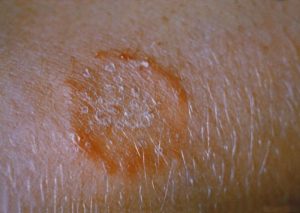
treated with over-the-counter topical creams and powders.
Fungi can also have devastating effects on wildlife. One striking example is white-nose syndrome, a fungal disease which affects hibernating bats. The fungus grows on the bats’ skin, particularly around the nose and wings, and disrupts their hibernation cycles. As a result, the bats wake more frequently, burn through their energy reserves, and often die of starvation. This disease has led to dramatic declines in bat populations across North America.
Knowledge Check
Text Description
- Cellulose
- Glycogen
- Chitin
- Keratin
- Mycelium
- Hyphae
- Fruiting body (mushroom)
- Rhizoids
- By ingesting food and digesting it internally
- Through photosynthesis using chloroplasts
- By secreting enzymes and absorbing nutrients externally
- By forming roots that absorb nutrients from soil
- Symbiogenesis
- Mycorrhizae
- Rhizobium
- Hyphal fusion
- Fungi grow faster than bacteria
- Fungi are not affected by antibiotics targeting prokaryotes
- Fungi lack DNA, making treatment hard
- Fungi reproduce only sexually
Answers:
- c. Chitin
- c. Fruiting body (mushroom)
- c. By secreting enzymes and absorbing nutrients externally
- b. Mycorrhizae
- b. Fungi are not affected by antibiotics targeting prokaryotes
OpenAI. (2025). ChatGPT. [Large language model]. https://chat.openai.com/chat
Prompt: Create 5 multiple-choice questions using the following content
“13.4 Fungi” from Biology and the Citizen by Colleen Jones is licensed under a Creative Commons Attribution 4.0 International License, except where otherwise noted. Modifications: Edited and reworded
“The Fungi Kingdom” from Introductory Biology: Ecology, Evolution, and Biodiversity by Erica Kosal is licensed under a Creative Commons Attribution-NonCommercial 4.0 International License, except where otherwise noted. Modifications: Edited and reworded

